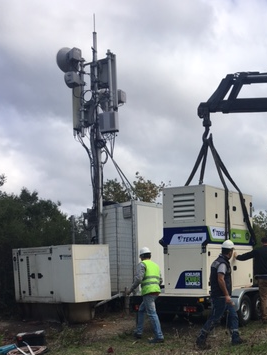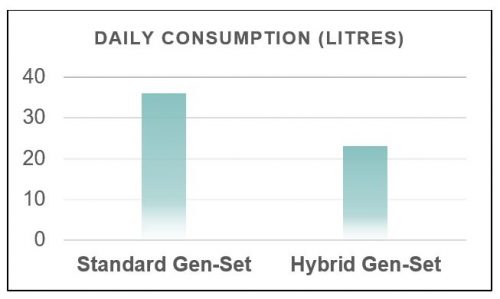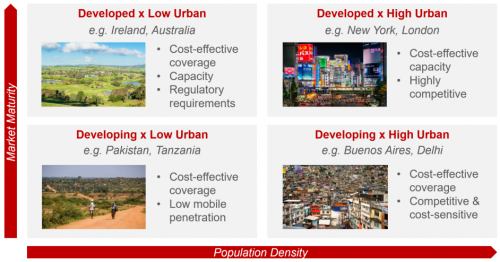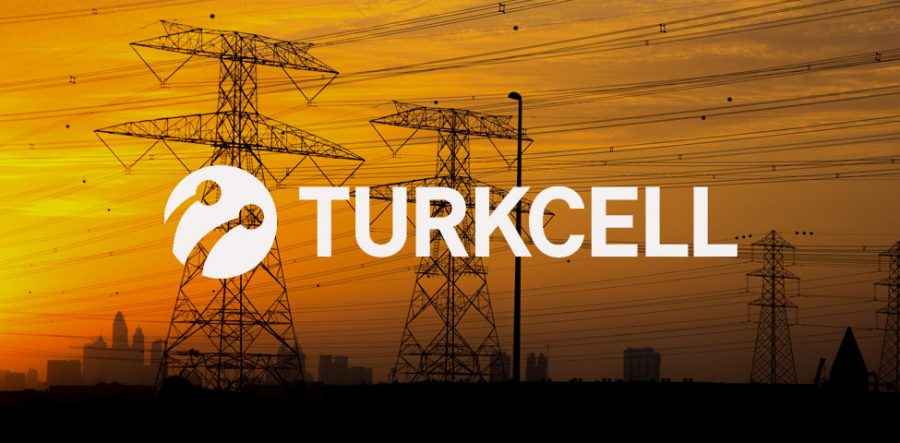Hybrid Generator Application in a Mobile Base Station Site
The GSM Association (“Association”) makes no representation, warranty or undertaking (express or implied) with respect to and does not accept any responsibility for, and hereby disclaims liability for the accuracy or completeness or timeliness of the information contained in this document.
Executive Summary
As part of the Future Networks Programme, Network Economics workstream, a series of case studies have been developed, exploring areas where Operators can potentially reduce their Operational Expenditure (OpEx) and Capital Expenditure (CapEX). This case study focuses on both the challenges and optimisation delivered by hybrid generator solution.
The case study centres on Telecom operators’ energy sources and diesel gen-set as a primary energy source for powering a base station site and the implementation of a hybrid generator, a new and more efficient generator technology.
Telecom operators benefit from the primary source of energy to power base station sites – grid energy where possible since grid energy is cheaper than compared to other sources and most of the time the grid has high availability. When the location where a Telecom operator needs to provide service does not have a reliable connection to the grid; diesel gen-sets can be the only alternative to power the base station site. These gen-sets consumes significant amount of fuel, resulting in high OpEx and carbon emissions. Instead of the traditional diesel gen-set, the installation of the Teksan Hybrid Generator can help to reduce carbon emissions and while reducing the OpEx by approximately 40%.
From the CapEx point of view, the cost of a hybrid generator is more than standard diesel gen-set however in this case study, when additional CapEx costs from hybrid gen-sets and OpEx savings are added, the RoI is calculated at around 2 years. In addition, the benefit of reduced carbon emissions is an important advantage of the hybrid generator solution.
About Turkcell
Turkcell is a digital operator headquartered in Turkey, serving its customers with its unique portfolio of digital services along with voice, messaging, data and IPTV services on its mobile and fixed networks. Turkcell Group companies operate in 5 countries – Turkey, Ukraine, Belarus, Northern Cyprus, and Germany. Turkcell launched LTE services in its home country on April 1st, 2016, employing LTE-Advanced and three-carrier aggregation technologies in 81 cities. Turkcell offers up to 10 Gbps fibre internet speed with its FTTH services. Turkcell Group reported TRY6.6 billion revenue in Q3 2019 with total assets of TRY45.5 billion as of September 30, 2019. It has been listed on the NYSE and the BIST since July 2000 and is the only NYSE-listed company in Turkey.
Read more at www.turkcell.com.tr
Introduction
Mobile Network Operators target to offer 99.999% network availability to their subscribers so that they can enjoy high quality, and uninterrupted service. The leading causes of interruption for a mobile operator in their base station sites are transmission problems, Telecom equipment faults and energy-related issues. Telecom equipment in mobile network operators’ base station sites requires continuous electricity. When there is a power outage, this causes an interruption in the service.
The primary source of energy to power base station sites is the grid. Telecom operators benefit from grid energy whenever possible since grid energy is cheap compared to other sources, and most of the time the grid has high availability. In case there is a grid failure, Telecom operator has to have backup power for continuous service and usually benefit from batteries as backup. There are different battery technologies, and the type of battery may vary depending on the capacity need, number of discharges expected and cost. The most popular battery technologies among Telecom operators are VRLA and Lithium, while Diesel gen-sets and hydrogen fuel cells are other (and additional) backup alternatives.
In some situations, the location where the Telecom operator needs to provide service may have little to no grid power available, and an alternative primary energy source to power the base station site will be needed. If there is enough space, solar energy is a good alternative – the main advantages of solar energy are low OpEx and low carbon emissions. However, the drawbacks to solar energy are its high CapEx, the need for a large area and potential availability problems due to low energy production when solar radiation is insufficient.
When a Telecom operator operates in an area where the grid is not available or reliable and solar is not a viable option – diesel gen-sets are a likely alternative to power the base station site. However, diesel gen-sets are not a solution that operators benefit from. They come with high CapEx and high OpEx cost and throughout the operation of diesel gen-sets, fuel and its logistics cost, periodic maintenance and repair cost in case of failure increase telecom operators’ operational expenses. In addition to this, the lead time of the fuel to the required location should also be considered as it may cause power reliability problems, along with fuel theft, which is a major drawback of diesel gen-sets.
When a diesel gen-set is used as a primary energy source, it usually works together with battery sets to increase its efficiency. When diesel gen-set starts, telecom loads are powered and at the same time batteries are charged. After batteries are charged, diesel gen-set stops and batteries are used to power telecom equipment until batteries reach a certain voltage level. Repeating this process avoids the diesel gen-set operating 24/7, making it possible to save on fuel.
Turkcell’s Energy Sources
Thanks to Turkey’s large grid coverage across the country, 99.9 % of Turkcell base station sites benefit from the grid. In a few locations where the grid is not available, renewable energy (solar and/or wind) is used to power the base station sites. However, in very few locations where grid is not available and large solar panel installation is not a viable option, Turkcell uses diesel gen-sets as a primary alternative energy source.
Diesel Powered Base Station Site
As mentioned above, powering a base station site with diesel gen-set has some disadvantages. In one of Turkcell’s base station sites, a diesel gen-set combined with lithium batteries is used. After the batteries are discharged to a certain level, the diesel gen-set started to charge the batteries and power the base station site at the same time. Lithium batteries were a preferred option for their fast charging ability and high number of cycle lifetime. Nevertheless, this creates a high fuel cost and contributes directly to carbon emissions. For a Telecom operator who has targets to reduce carbon emissions, the number of sites working with diesel gen-sets has to be reduced. That is why Turkcell tries to avoid this type of base stations within the network and strives to find alternative solutions to power the site.
Alternative Solution
In one of the Turkcell’s the base stations, which has a site load of approximately 1,5 kW, the only alternative to power this base station was a diesel gen-set with fuel consumption of around 36 litres per day, which creates for a high carbon emissions and high OpEx cost, making it possible for a new gen-set technology to be in focus.
One of the leading gen-set suppliers in Turkey is Teksan, they have recently introduced a new gen-set technology into the market, with a key selling point on it being more efficient in comparison to the standard diesel gen-sets. This new technology is called a ‘Hybrid Generator’.
In comparing the traditional diesel gen-sets, the AC output is converted to DC with the help of a rectifier. It also has a fixed speed motor, while the Hybrid Generators, on the other hand, have a variable speed motor and a DC alternator. With the help of variable speed motor, the Hybrid Generator is able to work more efficiently, and the DC alternator has a significant advantage for reducing losses caused by energy conversion.
The output power of the hybrid generator that was suitable for Turkcell base station was 10.3 kW, and the system had additional OPZV batteries. These batteries have high life cycle and are used for reducing the number of working hours of the gen-set by charge/discharge cycles.
Initial investigation and TCO analysis were positive, so it was decided to test the hybrid generator in the base station site. Turkcell and Teksan installation teams worked together to install the generator into the base station site. Installation was completed in around 6 hours.

Figure 1. Installation of Teksan Hybrid Generator
Above, a picture of the installation phase can be seen. In this picture;
1: The standard diesel gen-set used to power the base station site
2: The base station shelter and radio/transmission antennas
3: Teksan hybrid generator that was tested
Results
After the installation of the hybrid generator, daily fuel consumption was reduced by 36% to 23 litres which had a significant impact on reducing the fuel cost and carbon emissions that was emitted from the initial 36 litres daily fuel consumption with the traditional gen-sets.

Figure 2. Daily Consumption Comparison of Hybrid Generator and Standard Generator
Since fuel consumption decreased, the frequency of site visits to fuel the generator also decreased accordingly, which helped reduce logistics cost. Another advantage was the reduction of periodic maintenance cost. Previously standard diesel gen-set was working around 14 hours a day. After installation of hybrid generator, the working hours of generator was reduced to 10 hours, bringing an additional opportunity to reduce periodic maintenance.

Figure 3. OpEx savings and revenues per geographical region (Source: GSMA)
Conclusion
Telecom operators have a wide range of energy solutions in their networks. Although the grid is the most convenient solution for powering base station sites, it is not the most efficient in some scenarios. There are efficient options that can be considered for locations where grid power is not an option. In Turkcell’s situation, one of the base station sites where grid power was not available was powered with a traditional diesel generator, consuming significant amount of fuel, high OpEx and carbon emissions. With the implementation of the Teksan Hybrid Generator, OpEx cost was reduced by around 40% per base station sites in comparison to the traditional gen sets.
From the CapEx point of view, the cost of a hybrid generator is more than the cost of a standard diesel gen-set. However, when the hybrid generators were installed, the rectifier unit used in the initial set up was removed and used in another base station site, which offsets some of the CapEx cost.
Turkcell experienced an ROI of 2 years with the hybrid gen-set, in addition to economic perspective, the reduced carbon emissions is another important benefit.
